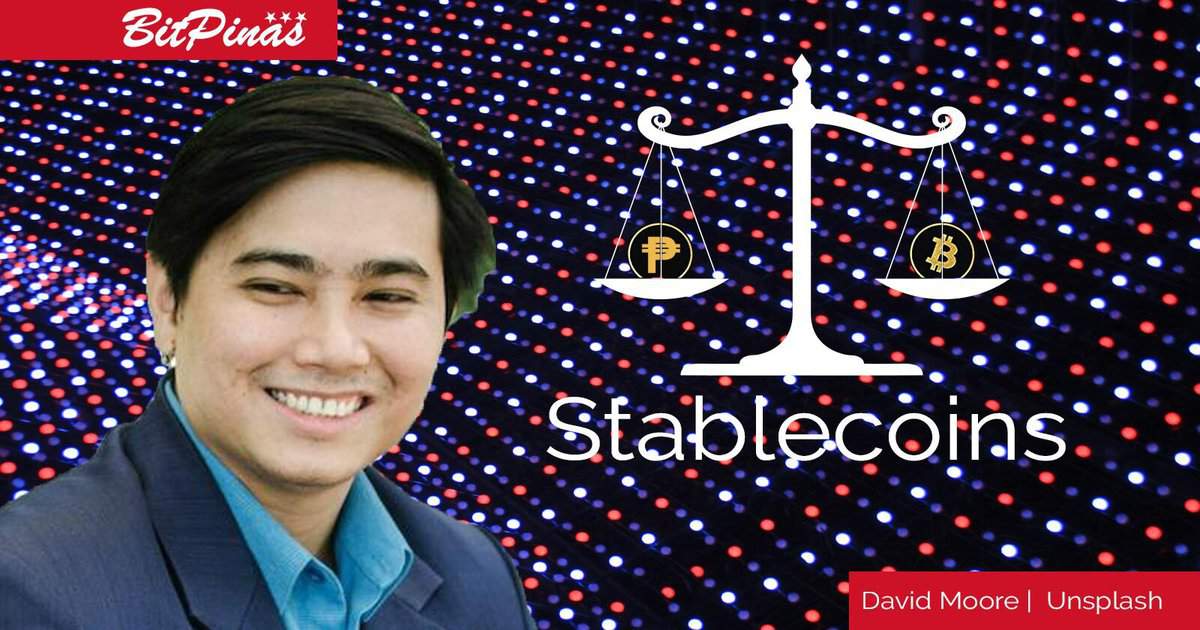Legal and Regulatory Aspects of Stablecoins by Atty. Rafael Padilla
While the use of stablecoins could implicate several aspects of the law, three areas attained some level of prominence within legal and policy circles: securities regulation, anti-money laundering (AML), and financial service licensing.

Atty. Rafael Padilla, Co-Founder and Trustee of BlockDevs Asia and Professor of Law at San Beda Alabang, examined stablecoins, its issuances, and the legal and regulatory ramifications of such within key areas of securities regulation, anti-money laundering and financial service licensing. Rafael also recently published the book Fintech: Law and First Principles. You can download the whitepaper here or read it below:
Legal and Regulatory Aspects of Stablecoins
Professor of Law, San Beda Alabang School of Law
Co-Founder & Trustee, BlockDevs Asia
https://www.blockdevs.asia/
rafpadilla@farcovelaw.com
30 October 2020
ABSTRACT: The legal and regulatory ramifications of stablecoins in the Philippines and beyond should be examined considering key factors such as the facts and circumstances surrounding the stablecoin issuance, its technical design and stabilization mechanism, the administrative structure of governance (centralized vis-à-vis decentralized), the specific use case for the stablecoin, and the rights and obligations of parties involved in a transaction. While the use of stablecoins could implicate several aspects of the law, three areas attained some level of prominence within legal and policy circles: securities regulation, anti-money laundering (AML), and financial service licensing.
1. Introduction
One of the peculiar characteristics of conventional cryptocurrencies is the high volatility of their value in the token market. This is often frowned upon by merchants because of the added complexity in accounting, while professional traders are delighted by the unpredictability as it opens more opportunities for profit. Stablecoins are designed to take advantage of cryptocurrency’s instant settlement feature and at the same time introduce stability to the value of the digital asset.
A stablecoin is a special type of digital asset specifically engineered to ensure that it maintains its peg to a fixed target price. Stability of value may be achieved through various technology approaches, economic incentives or collateral arrangement. Some stablecoins may be backed by legal tender (i.e., “fiat-backed”), commodity, or another cryptoasset. Fiat-backed stablecoins are usually redeemable for the underlying fiat currency, where one unit of the stablecoin can be exchanged for one unit of the underlying fiat currency. Other types of stablecoins may be more complex, decentralized, backed by a basket of assets, or managed by algorithm (i.e., algorithmic stablecoins).[1] A reliable stablecoin (i.e., consistently stable) could enable a variety of use cases in financial services. Stablecoins have gained significant traction as a medium of payment outside the conventional banking system, remittance, as a hedge against weak fiat currencies in economies marred by hyperinflation, and as a form of leverage in trading cryptoassets. However, it should be clarified that the term “stablecoin” does not suggest that the token’s value will always be stable, nor should it be construed as an endorsement or legal guarantee of the value or stability of these types of cryptoassets.[2]
Stablecoins, especially decentralized primitives like DAI, play a critical role in the decentralized finance (DeFi) ecosystem. Because they are designed to stabilize the value of a digital asset, many DeFi projects encourage the use of stablecoins in their platform due to their viability as a medium of exchange and unit of account within the DeFi ecosystem, as compared to other volatile cryptocurrency alternatives. However, stablecoins present another round of challenges to regulators who are already grappling with general issues concerning cryptocurrencies[3] and “the category-defying changes that cryptocurrency poses.”[4]
Understanding the legal and regulatory ramifications of stablecoins entails analysis of key factors such as the facts and circumstances surrounding the stablecoin issuance; its technical design and stabilization mechanism; the administrative structure of governance (centralized vis-à-vis decentralized); the rights and obligations of parties involved in transacting the stablecoin; and the specific use case for the stablecoin. That said, some legal areas stand out when it comes to stablecoins. Since the concept first emerged in 2014, legal questions about stablecoins have been explored mainly through the lenses of securities law, anti-money laundering (AML), and financial service regulation (i.e., licensing or chartering).
2. Stablecoins vis-à-vis securities regulation
Under Section 3.1 of the Securities Regulation Code, the term “securities” includes notes, investment contracts, and derivatives like options and warrants, among others. Most currency-backed stablecoins are issued when a purchaser deposits money (e.g. USD100.00) with a stablecoin issuer (e.g. Tether), and in exchange, the issuer mints and returns an equivalent amount of stablecoins (e.g. 100 USDT tokens). The token holder can later redeem the funds he or she deposited by returning the stablecoin to the issuer. Considering this redemption, it is possible under certain circumstances that a securities regulator will view such stablecoin as “demand note”, which is a two-party negotiable instrument binding a debtor to pay the noteholder at any time upon request.
In the United States, it was held in Reves v. Ernst& Young [5] that demand notes are presumed to be securities, unless an exemption or exclusion applies. The U.S. Supreme Court however clarified that notes are not securities per se. As explained by the Court:
“Congress’ purpose in enacting the securities laws was to regulate investments, in whatever form they are made and by whatever name they are called. However, notes are used in a variety of settings, not all of which involve investments. Thus, they are not securities per se, but must be defined using the “family resemblance” test. Under that test, a note is presumed to be a security unless it bears a strong resemblance, determined by examining four specified factors, to one of a judicially crafted list of categories of instrument that are not securities. If the instrument is not sufficiently similar to a listed item, a court must decide whether another category should be added by examining the same factors.” [6]
Some stablecoins are structured in a manner that resembles an option, warrant, note, equity or some other multi-layered financial derivative, which could potentially categorize the stablecoin as security. The case of Basis demonstrates this lesson. In 2018, the Basis Project in the United States raised 133 million dollars from a number of prominent funds and venture capital firms, only to shut down and refund those investments eight months later. The Basis protocol was designed to maintain stability by selling through auctions “bond” and “share” tokens to investors who would profit as long as the Basis stablecoin maintains its peg. It seemed obvious that such bond tokens and share tokens would be viewed as an investment contract under federal securities law. Unfortunately, registering the bond token and the share token or applying for exemption was not an option for the Project because registration will subject the token to transfer restrictions which would require the curation of a centralized whitelist. This would not only compromise the protocol’s censorship resistance, it would also greatly reduce the liquidity of on-chain auctions. Illiquidity will make it impossible to keep the peg, thus defeating the purpose of the Basis stablecoin. Alternative approaches were considered by the Basis team but they were not compelling and competitive enough, which ultimately led to the decision to shut down the project.[7]
Depending on the circumstances, a stablecoin might also be treated as a swap which is an option for the purchase or sale, or based on the value, of one or more interest or other rates, currencies, commodities, or other financial or economic interests or property of any kind. A stablecoin may also be regarded as what is known in financial markets as “collateralized FX swap.”[8] Consistent with this definition, a fiat currency-backed stablecoin could be characterized as an option for the purchase of, or based on the value of, fiat currencies. Derivatives like options and warrants are included within the definition of a security.[9]
One of the arguments against the notion that a stablecoin may be characterized as a security is the fact that its price is stable and fixed to its peg; therefore, its holder can neither speculate nor expect profits from holding stablecoins. This is admittedly a strong argument, only that it is not conclusive. It is also true that stablecoins are principally designed to maintain its value, not to generate profits for its holders. But any reference to “expectation of profits” is relevant only when the question is whether an instrument is an investment contract, one of the securities listed in Section 3.1 of the Securities Regulation Code. The long list of course contains other classes of securities:
“SECTION 3. Definition of Terms. — 3.1. “Securities” are shares, participation or interests in a corporation or in a commercial enterprise or profit-making venture and evidenced by a certificate, contract, instrument, whether written or electronic in character. It includes:
(a) Shares of stock, bonds, debentures, notes, evidences of indebtedness, asset
backed securities;
(b) Investment contracts, certificates of interest or participation in a profit
sharing agreement, certificates of deposit for a future subscription;
(c) Fractional undivided interests in oil, gas or other mineral rights;
(d) Derivatives like option and warrants;
(e) Certificates of assignments, certificates of participation, trust certificates, voting trust certificates or similar instruments;
(f) Proprietary or nonproprietary membership certificates in corporations;
and
(g) Other instruments as may in the future be determined by the Commission.”
Even in the context of investment contracts, amid an economic era marked by quantitative easing[10] and negative interest rates,[11] maintaining the value stored in a stablecoin without significant depreciation could be enough to satisfy the “expectation of profits” prong of the Howey Test. The motivation of the tokenholder, rather than the form of “profit”, should be considered in analyzing whether a stablecoin constitutes an investment contract.
In September 2020, the U.S. Securities and Exchange Commission (SEC) issued a Public Statement to clarify the legal position of stablecoin: “(w)hether a particular digital asset, including one labeled a stablecoin, is a security under the federal securities laws is inherently a facts and circumstances determination. This determination requires a careful analysis of the nature of the instrument, including the rights it purports to convey, and how it is offered and sold.”[12] While determining whether a stablecoin behaves like a security depends on specific facts and circumstances, it is believed that stablecoins that are algorithmically derived or those that are not “provably fully-backed” by collateral are exposed to a higher risk that they would be regarded as security. Nevertheless, in the same Statement noted above, the U.S. SEC also confirmed that a project (including stablecoin issuers) may structure and sell a digital asset in such a way that it does not constitute a security and implicate the registration, disclosure, reporting, and other requirements imposed by securities law.[13]
3. Money laundering risks associated with stablecoins
With respect to Anti-Money Laundering (AML) and Combatting of Financing of Terrorism (CFT), the Financial Action Task Force (FATF) has issued guidance on the money laundering risks associated with stablecoins, which was prompted by the rising adoption of this unique type of cryptoasset for trading and other cross-border transactions:
“Emerging assets such as so-called global “stablecoins”, and their proposed global networks and platforms, could potentially cause a shift in the virtual asset ecosystem and have implications for the money laundering and terrorist financing risks. There are two concerns: mass-market adoption of virtual assets and person-to-person transfers, without the need for a regulated intermediary. Together these changes could have serious consequences for our ability to detect and prevent money laundering and terrorist financing.”
“In general terms, both global “stablecoins” and their service providers would be subject to the FATF standards either as virtual assets and virtual asset service providers or as traditional financial assets and their service providers. They should never be outside the scope of anti-money laundering controls.”[14]
“While decentralised so-called stablecoins without such an identifiable central body, prima facie, may carry greater ML/ TF risks due to their diffuse operation, the FATF considers that their potential for mass-adoption is lower than centralized arrangements and, therefore, their associated ML/TF risks are smaller (although still present). However, even in a decentralised structure, there could also be a range of entities with AML/CFT obligations, including customer-facing exchanges and transfer services and custodial wallet providers. Importantly, there are functions that may mean an entity has AML/CFT obligations prior to the launch of a decentralised so-called stablecoin, as the process necessary to bring a product to launch is unlikely to be able to be fully decentralised.”[15]
4. Licensing implications of stablecoins
With respect to financial service regulation, it has been observed that some stablecoins are minted in a manner that can be construed as issuance of electronic money. In the Philippines, an electronic money or e-money means monetary value as represented by a claim on its issuer that is (1) electronically stored in an instrument or device; (2) issued against receipt of funds of an amount not lesser in value than the monetary value issued; (3) accepted as a means of payment by persons or entities other than the issuer; and (4) withdrawable in cash or cash equivalent.[16]
It is believed that the Bangko Sentral ng Pilipinas’ (BSP) regulation of Virtual Currency Exchange[17] does not apply to stablecoin projects that as a business do not facilitate their conversion to fiat currency. In this context, the issuance and the redeemability of a fiat backed stablecoin should not be interpreted as conversion or exchange of “fiat currency to virtual asset, and vice versa.” This is because the fiat currency here is deposited to the token issuer to collateralize the stablecoin as its way of maintaining the peg. Neither the holder nor the token issuer intends to trade the fiat currency for stablecoin, and there is always an undertaking from the token issuer that the stablecoin is redeemable for an equivalent unit of fiat currency deposited by the tokenholder.
Centralized stablecoin issuers, as distinguished from decentralized stablecoin projects, should also consider how facilitating payments, using their stablecoin as medium of exchange, could implicate payment service regulations. The same can be said to an independent service provider that process payments for customers by taking advantage of stablecoins especially in cross-border transactions. The relevant legal framework in this scenario is the National Payment Systems Act.[18]
Moreover, the financial stability implications of stablecoins should be considered. Because of their innate low volatility and considering that their digital nature enable usage to scale quickly, stablecoins could become attractive payment instruments for consumers, merchants and enterprises. Consequently, stablecoins have the potential of becoming systemically important within the domestic payment system, through the substitution of the local currency, or even on a global scale.[19] Indeed, according to the Financial Stability Board (FSB), stablecoins could pose regulatory and supervisory challenges at the international level:
“Such challenges could involve the compatibility of national approaches or potential outright gaps resulting from the global nature of stablecoin arrangements. Hence, analysis would focus on understanding how the existing international standards and principles support effective regulatory and supervisory cooperation in addressing risks to global financial stability and market functioning arising from stablecoins; and what, if any, actions may be needed to further strengthen cooperation and coordination to address global financial stability and systemic risk concerns.”
In the United States, some currency-backed stablecoin issuers obtained state-issued limited purpose trust company charters, which authorizes them to engage in specific trust functions such as depositing and safekeeping of assets. The principle is that these stablecoin issuers act as trustees, administering financial assets on behalf of the stablecoin users. Taking the role of a fiduciary, a stablecoin issuer/trust company undertakes to manage, record, monitor and safeguard the assets under its control. In the Philippines, trust companies, are regulated by the BSP. Under Sec. 79 of the General Banking Law:[20] “(o)nly a stock corporation or a person duly authorized by the Monetary Board to engage in trust business shall act as a trustee or administer any trust or hold property in trust or on deposit for the use, benefit, or on behalf of others.” As a fiduciary, the General Banking law requires a trust entity to “administer the funds or property under its custody with the diligence that a prudent man would exercise in the conduct of an enterprise of a like character and with similar aims.”[21]
In other scenarios, a redeemable stablecoin that is collateralized by tangible assets, or even by other intangible assets such as securities except cryptocurrencies, may be viewed as unit trust depending on its structure and other factors.[22] In general, such unit trusts, such as collective investment schemes, are governed by the Investment Company Act[23] and the relevant provisions of the Securities Regulation Code.[24] Based on the Implementing Rules and Regulations of the Investment Company Act, this could entail setting up a Mutual Fund Company (MFC) that will issue units of participation each of which represents an undivided interest in the pool of investment assets of the scheme.[25] However, the Investment Company Act might not be applicable in some cases, especially when it comes to decentralized stablecoins. Determining the regulations that apply to an asset-backed stablecoin will ultimately depend on the nature of the collateral.
Applying for a financial service license or charter also means that the stablecoin would have to be designed in a manner that would enable compliance with financial regulations.[26]
For various reasons including technical and economic, not all stablecoin projects could afford redesigning their architecture to qualify for regulatory approvals. The case of Basis, discussed above, once again comes in mind. But for those who can afford to redesign their platforms, specifically issuers with a centralized stablecoin framework, they should set and implement adequate governance programs, know-your-client (KYC), AML measures, data privacy and cyber-resilience, in compliance with the standards set by financial regulators.
5. Conclusion: The future of stablecoins
In the United States, the Office of the Comptroller of the Currency (OCC) under the U.S. Department of the Treasury has issued official guidance clarifying that federally chartered national banks and savings associations can legally hold reserve funds for stablecoin issuers. However, the Interpretative Letter applies only to the use of stablecoin backed on a 1:1 basis by a single fiat currency where the bank verifies that reserve account balances are always equal to or greater than the number of the issuer’s outstanding stablecoins.[27] According to the OCC: “national banks may provide permissible banking services to any lawful business they choose, including cryptocurrency businesses, so long as they effectively manage the risks and comply with applicable law, including those relating to the BSA and anti-money laundering. Accordingly, national banks may receive deposits from stablecoin issuers, including deposits that constitute reserves for a stablecoin associated with hosted wallets. In connection with these activities, a national bank may also engage in any activity incidental receiving deposits from stablecoin issuers.”[28]
As a final note on the regulatory consequences of stablecoins, the Bank for International Settlements (BIS) examined the legal characterization of stablecoins. As use cases for stablecoins continue to evolve, the BIS summarized the important considerations as follows:
“As regards the legal characterization of stablecoins, the most relevant determinative factors are whether or not they are considered as a money equivalent; categorized as contractual claims or property rights; or entail a right against an issuer or against underlying assets. In some jurisdictions, stablecoins may constitute a security or financial instrument, such as a debt instrument, or represent an interest in a fund or collective investment vehicle and be subject to applicable laws relating to securities and financial instruments. Particular issues may arise in a cross-jurisdictional context, as there is a need to determine which jurisdiction’s law applies to individual elements in the overall design and which jurisdiction’s courts have competency to settle disputes. There is also a potential for conflicts of law, given the different treatments in different jurisdictions. The applicable financial sector law in certain jurisdictions may not be keeping pace with new business models and market activity such as stablecoins. A number of recent initiatives by national authorities are seeking to address this uncertainty. Where an arrangement relies on (distributed ledger technology) to record and transfer monetary value, careful consideration must be given to the legal underpinning of such an arrangement which must be at least as robust as traditional systems. For example, the legal basis regarding the rights and obligations of the relevant parties and settlement finality must always be clear.” [29]
This article is first published on BitPinas: Legal and Regulatory Aspects of Stablecoins by Atty. Rafael Padilla
References
[1] OCC Interpretive Letter #1172, October 2020, p. 3. (https://www.occ.gov/topics/charters-and licensing/interpretations-and-actions/2020/int1172.pdf)
[2] Financial Stability Board (FSB), Regulatory Issues of Stablecoins, p. 1-2, https://www.fsb.org/wp content/uploads/P181019.pdf (2019).
[3] David Furlonger & Christopher Uzureau, The Real Business of Blockchain, Harvard Business Review Press p. 136 (2019).
[4] Michael Casey & Paul Vigna, The Truth Machine: The Blockchain and The Future of Everything, p. 52 (2018)
[5] 494 U.S. 56 (1990)
[6] Reves v. Ernst & Young, 494 U.S. 56 (1990)
[7] Basis Statement Dated 13 December 2018 (https://www.basis.io/)
[8] Preston Byrne, 13 July 2017
[9] Sec. 3.1(d), Securities Regulation Code (2000)
[10] Quantitative easing is a monetary policy that involves a central bank or monetary authority purchasing financial instruments from financial institutions usually as a last-resort measure to inject money and credit into the economy and hopefully stimulate productive activities.
[11] Negative interest rate contemplates a bizarre scenario where the borrower is credited with interest, instead of paying interest. This happens after monetary policy and market forces have already brought interest rates down to 0%, but there is still a need to incentive financial institutions to lend to borrower rather than hoard funds.
[12] U.S. SEC, Public Statement, SEC FinHub Staff Statement on OCC Interpretation, 21 September 2020 (https://www.sec.gov/news/public-statement/sec-finhub-statement-occ-interpretation)
[13] Id
[14] FATF, Money Laundering Risks From “Stablecoins” and Other Emerging Assets, 18 October 2019 http://www.fatf-gafi.org/publications/fatfgeneral/documents/statement-virtual-assets-global-stablecoins.html
[15] FATF Report to the G20 Finance Ministers and Central Bank Governors on So-called Stablecoins, July 2020, https://www.fatf-gafi.org/publications/fatfgeneral/docu- ments/report-g20-so-called-stablecoins-june 2020.html
[16] BSP Circular 649; Guidelines on Issuance of Electronic Money (2009)
[17] BSP Circular 944; Guidelines on Virtual Currency Exchanges (2017)
[18] R.A. No. 11127 (2018)
[19] FSB, Regulatory Issues of Stablecoins, p. 1-2, https://www.fsb.org/wp-content/uploads/P181019.pdf (2019)
[20] R.A .No.8791 (2000)
[21] Sec. 80, General Banking Law (2000)
[22] Preston Byrne (2017)
[23] R.A. No. 2629 (1960)
[24] R.A. No 8799 (200)
[25] Implementing Rules and Regulations of the Investment Company Act (2017)
[26] For example, the New York Department of Financial Services (NYDFS) requires following stringent measures in approving currency-backed stablecoins
[27] OCC Interpretive Letter #1172, October 2020. (https://www.occ.gov/topics/charters-and licensing/interpretations-and-actions/2020/int1172.pdf)
[28] Id, p. 4 (2020)
[29] Bank for International Settlements, Investigating the Global Impact of Stablecoins, https://www.bis.org/cpmi/publ/d187.pdf (2019)





